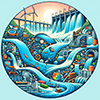Hydraulic and Civil, Beginner: CFD Simulation Training Course — Ep 01
Waterfall using Two-Phase Flow CFD Simulation
- Episode
- 01
- Run Time
- 13m 14s
- Published
- Oct 10, 2024
- Topic
- Hydraulic
- Course Progress
- 0%
Mastering Waterfall Dynamics: Two-Phase Flow CFD Simulation for Beginners
Welcome to the “Waterfall using Two-Phase Flow CFD Simulation” episode of our “HYDRAULIC Engineers: BEGINNER” course. This comprehensive module introduces civil engineers to the fascinating world of waterfall hydraulics using computational fluid dynamics (CFD). Learn how to leverage ANSYS Fluent to simulate and analyze the complex behavior of waterfalls, a crucial skill for innovative hydraulic structure design and water resource management.
Understanding the Importance of Waterfalls in Hydraulic Engineering
Before diving into the simulation specifics, let’s explore the fundamental concepts of waterfalls and their significance in civil engineering applications.
The Role of Waterfalls in Natural and Engineered Systems
Discover how waterfalls contribute to landscape design, stormwater management, and energy dissipation in hydraulic structures like dam spillways.
Challenges in Modeling Waterfall Dynamics
Learn about the complexities involved in accurately representing waterfall behavior, including free-fall conditions and air entrainment.
Introduction to ANSYS Fluent for Waterfall Analysis
This section focuses on familiarizing beginners with the ANSYS Fluent software environment:
Navigating the ANSYS Fluent Interface
Gain insights into the basic layout and functionality of ANSYS Fluent, essential for efficient simulation setup and analysis of waterfall structures.
Understanding the CFD Workflow for Waterfall Simulations
Learn the step-by-step process of setting up, running, and analyzing a waterfall CFD simulation in ANSYS Fluent.
Setting Up a Basic Waterfall Model
Master the art of creating a simple simulation environment for waterfall hydraulics:
Defining Geometry and Mesh for Waterfall Simulations
Learn techniques for creating a basic geometry representing a waterfall configuration, along with appropriate meshing strategies for accurate flow analysis.
Configuring Two-Phase Flow Properties in ANSYS Fluent
Explore methods for defining and implementing the properties of water and air in your waterfall simulation.
Boundary Conditions for Waterfall Scenarios
Dive into the critical settings that ensure realistic representation of water flow in waterfall configurations:
Specifying Inlet and Outlet Conditions
Understand how to set up appropriate inlet flow rates and outlet conditions that accurately represent various waterfall scenarios.
Implementing Free Surface and Wall Boundary Conditions
Learn to define proper boundary conditions for the water surface, air interface, and solid boundaries to capture realistic waterfall behavior.
Running Basic Simulations of Water Flow in a Waterfall Configuration
Develop skills to execute and monitor your first waterfall CFD simulations:
Setting Up Solver Parameters for Hydraulic Simulations
Master the basics of configuring solver settings, including time-stepping and convergence criteria, suitable for waterfall flow simulations.
Monitoring Simulation Progress and Ensuring Stability
Learn techniques for tracking simulation progress and identifying potential issues during the solving process.
Analyzing Fundamental Flow Patterns and Velocity Distributions
Develop expertise in extracting meaningful insights from your waterfall simulations:
Visualizing Water Flow Patterns in Waterfall Structures
Master techniques for creating insightful visualizations of velocity fields and streamlines to understand flow behavior in waterfall configurations.
Interpreting Velocity Distributions and Air Entrainment
Learn to analyze velocity profiles and air entrainment patterns, crucial for assessing waterfall performance and downstream impact.
Introduction to Free Surface Modeling in Hydraulic Structures
Explore the basics of capturing the water-air interface in your simulations:
Understanding the Concept of Free Surface in Waterfall Flow
Gain insights into how free surface modeling represents the dynamic interface between water and air in waterfall scenarios.
Basic Techniques for Visualizing Free Surface in Waterfall Simulations
Learn introductory methods for identifying and interpreting free surface behavior in your waterfall simulation results.
Practical Applications and Civil Engineering Relevance
Connect simulation insights to real-world hydraulic engineering challenges:
Applying CFD Insights to Waterfall Design and Analysis
Explore how the flow patterns and velocity distributions observed in CFD simulations can inform waterfall design decisions and performance assessments.
Understanding the Limitations of Beginner-Level Simulations
Gain awareness of the simplifications in this introductory course and the potential for more advanced analyses in future studies.
Why This Module is Essential for Beginner Hydraulic Engineers
This beginner-level module offers an introduction to the powerful world of CFD in waterfall analysis. By completing this simulation, you’ll gain valuable insights into:
- Basic application of ANSYS Fluent for simulating two-phase flow in waterfall scenarios
- Essential CFD techniques for capturing flow patterns and air entrainment in free-fall conditions
- Practical applications of CFD analysis in landscape design and hydraulic structure optimization
By the end of this episode, you’ll have developed foundational skills in:
- Setting up and running basic waterfall flow simulations using ANSYS Fluent
- Interpreting simulation results to assess hydraulic characteristics of waterfalls
- Applying CFD insights to enhance understanding of waterfall behavior and inform design decisions
This knowledge forms a solid foundation for civil engineers looking to integrate advanced computational methods into their hydraulic structure design and analysis toolkit, providing a springboard for more advanced studies in water resource engineering and environmental hydraulics.
Join us on this exciting journey into the world of waterfall CFD simulation, and take your first steps towards becoming a proficient hydraulic engineer equipped with cutting-edge computational tools for innovative water feature design and analysis!

